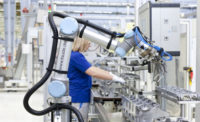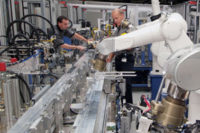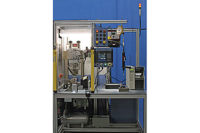Manufacturers in Germany, like those in the United States, are coping with three major issues: a highly dynamic market, increasing competition due to globalization, and a shortage of skilled workers. These issues are particularly challenging for product assembly, since it’s the last link in the value chain.
Many manufacturers believe that human-robot collaboration can help them overcome these challenges. However, many manufacturers have yet to implement human-robot collaboration projects due to concerns over cost and personnel. For human-robot collaboration to truly take off, simple, flexible methods will be necessary to enable companies from a variety of industries with a variety of needs to set up collaborative assembly workstations.
This is the premise behind the SafeMate research project, which is funded by the German Federal Ministry of Education and Research. The goal is to create safe and accepted workplaces where employees recognize a high benefit to robotic automation. Several major German manufacturers from a variety of industries are participating in the project, including Lenze, a manufacturer of motion control technology; Lufthansa Sky Chefs, a manufacturer of food for airliners; Miele, a manufacturer of household appliances; and Sennheiser, a manufacturer of audio equipment.
Another participating company is Weidmüller, a manufacturer of electrical connection technology and electronics based in Detmold, Germany. The company’s products are used in the process industries, transportation equipment, power generation, and building infrastructure.
Until recently, the assembly process for a particular electromechanical component at Weidmüller was carried out completely manually. As part of SafeMate, an engineering team at Weidmüller, led by process engineer Tobias Stuke, conducted an analysis to determine which tasks were best-done manually and which could be done by machine. Among other things, the team found that robots are very good at performing the monotonous, repetitive and power-intensive tasks of the placement process without fatigue. And, they can do so with consistent accuracy.
However, assembly cannot be done entirely without people. For example, people are better at gripping and removing small parts of different dimensions from a pile or box. They can recognize and sort them better. People are also superior to their robotic colleagues for the inspection process.
Based on these findings, the manual assembly process was partially automated following a human-robot collaboration model. The result was a hybrid assembly workplace in which people and robots work in parallel. The monotonous and force-intensive tasks are performed by the robot, while the cognitively demanding tasks are carried out by people.
In collaborative robotics, people and robots work side by side at one workplace. Due to their sensitive control technology, cobots can work closely with people without protective fences. Such applications require validation to ensure that hazards have been sufficiently minimized. This can be done by professional associations, external service providers, system integrators or Technischer Überwachungsverein (TÜVs), or Technical Inspection Associations, which are independent international service companies from Germany and Austria that test, inspect and certify technical systems, facilities and machines of all kinds to minimize hazards and prevent damages. End-of-arm tools, such as grippers, can also be validated in this way.
To assemble electromechanical components, Weidmüller deployed a cobot from Universal Robots. First, the person assembles the connector elements. Then, the cobot presses in the electrical contact elements, joins the connector housing and screws on the connection contacts. The goal of this partial automation is to relieve the worker of the time-consuming and monotonous intermediate steps and thus achieve a balanced division of labor between people and robots. Productivity has also increased.
The cobot is equipped with the HRC-02 two-jaw parallel gripper from the Zimmer Group, a gripper specialist based in Rheinau, Germany. The gripper is safe and harmonizes perfectly with the cobot. The all-electric servo gripper has no sharp edges. Its rounded shape on all sides ensures that accidental snagging is virtually impossible. The gripper’s stroke length and gripping force are adjustable, allowing it to grip much more sensitively than a conventional gripper. The gripper meets the safety requirements set forth in the ISO/TS 15066 standard for human-robot collaboration, and it is certified by the DGUV, Germany’s equivalent of OSHA.
From Manual Assembly To Automation
In addition to ergonomics, another focus of the project was to determine if the cobot could be used efficiently and flexibly. Engineers paid particular attention to handling and programming of the cobot. The results were convincing, especially in combination with the HRC-02 gripper.
It’s no coincidence that Zimmer grippers work perfectly with UR cobots. Zimmer has been a UR+ partner for several years. UR+ is a platform of third-party components and application kits that have been certified by Universal Robots to work with its products. The UR+ platform now includes more than 300 partners and 400 certified components and application kits. Because its UR+ certified, the Zimmer gripper can be programmed directly through the cobot’s control panel. Complex programming skills are not required.
The gripper is operated by digital signals: one signal for closing the gripper jaws and a second signal to open the jaws. A part-present signal is provided by analog sensing. The gripper can detect different workpiece dimensions without repositioning the sensor.
The gripper allows easy teaching of the robot thanks to an integrated free-drive button. Direct connection to tool I/O and direct assembly to the robot flange simplify installation and operation of the gripper. Self-locking protects the workpiece from dropping even in the event of an emergency stop or power failure.
Weidmüller’s pilot project was successful, and it has opened up new possibilities for the manufacturer. In addition to increasing productivity, the project yielded nonmonetary benefits. For example, monotonous and force-intensive tasks, such as pressing in the contact elements, are now handled by the cobot. That helped to achieve buy-in and acceptance from workers, who were involved in the change process from the beginning. Automation also means that Weidmüller can better cope with the shortage of skilled workers. Automating monotonous and stressful tasks enables Weidmüller to redeploy skilled workers where they’re needed most.
“One reason we chose the Zimmer gripper, aside from its technical features, was that it had already been tested and certified as safe for human-robot collaboration systems,” says Stuke. “It is particularly important to the company that its employees benefit from collaborative work. The cobots with their grippers are intended to provide relief.”






